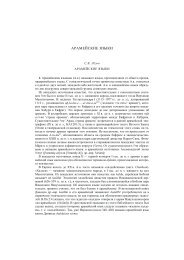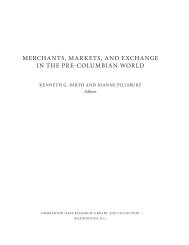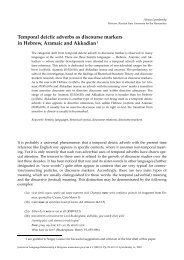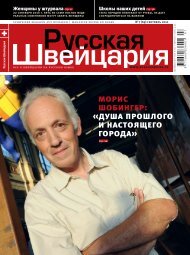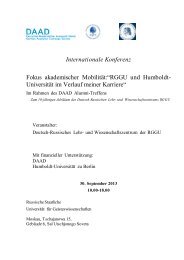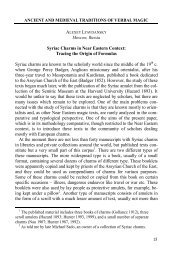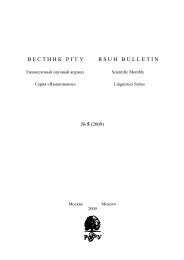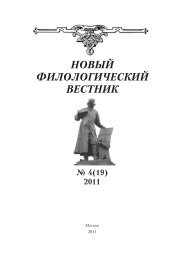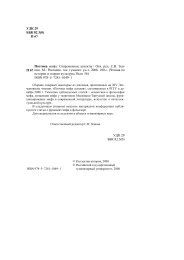Akkadian Sentences about the Present Time (II/2)
Akkadian Sentences about the Present Time (II/2)
Akkadian Sentences about the Present Time (II/2)
You also want an ePaper? Increase the reach of your titles
YUMPU automatically turns print PDFs into web optimized ePapers that Google loves.
762 Morphosyntax and Text Structure in <strong>Akkadian</strong>berg forthcoming 7.3 argues: “In terms of semantic transitivity, stativeshave ‘zero transitivity,’ since <strong>the</strong>y do not indicate a change in <strong>the</strong> state of<strong>the</strong> world. Accordingly, <strong>the</strong>y cannot have an agentive subject, since agentivityimplies a conscious volitional act on <strong>the</strong> part of <strong>the</strong> subject and is<strong>the</strong>refore only applicable to actions.” Binnick 1991:187, to whom K. refersat this juncture, indeed says: “States are largely involitional, involuntary.Therefore <strong>the</strong>y cannot be agentive, and consequently any structurepresupposing agency, for example […] <strong>the</strong> imperative (be tall !) is excluded.”Yet, in <strong>Akkadian</strong> <strong>the</strong> SC can have an agentive grammatical subject,e. g. it is used within <strong>the</strong> prohibitive construction (and with <strong>the</strong> directionalventive!): ana eqlim šuāti mamman lā ¢e 4 -i-a-am ‘nobody has toapproach this field!’ (AbB 4, 125:14).An interim conclusion from this study, focused on <strong>the</strong> ways <strong>the</strong> SCand <strong>the</strong> Pres. of individual verbs are used in OB and OA, suggests that<strong>the</strong> SC is more unpredictable than GAG and subsequent grammatical researchhave it. According to GAG 126f., <strong>the</strong> only important restriction on<strong>the</strong> formation of <strong>the</strong> SC is <strong>the</strong> atelic semantics of a given verb, which istrue in many cases (but not always, cf. <strong>the</strong> list of verbs in fn. 7). Kouwenbergforthcoming 7.3 claims (following GAG) that “<strong>the</strong> fientive verb itselfmust be telic in order to have a stative at all,” yet this claim is not sharpenough. Indeed, <strong>the</strong> criterion of (a)telicity may turn out to be not thatcrucial. 8 Now, let us recall <strong>the</strong> semantic taxonomies of verbs that are currentin typological studies (as described in Loesov 2005): very roughly,<strong>the</strong>se taxonomies are based on <strong>the</strong> four Vendlerian classes (states, atelicprocesses, telic processes, punctual events), combined with <strong>the</strong> criteria ofagentivity and transitivity (<strong>the</strong> latter understood both syntactically andsemantically). If we <strong>the</strong>n examine a given cross-linguistically identifiablesemantic group of <strong>Akkadian</strong> verbs, we will be unable to tell from <strong>the</strong>irprima facie semantic and syntactic properties whe<strong>the</strong>r <strong>the</strong>ir SC is productiveand whe<strong>the</strong>r it appears in our records at all, and if it does, what itmeans. By contrast, as regards <strong>the</strong> Pres. and Pret., we can safely assume<strong>the</strong>ir existence and predict <strong>the</strong>ir meanings for most dictionary items of<strong>the</strong> G-stem (<strong>the</strong> few conspicuous exceptions are well-known and enteredin textbooks and reference grammars of <strong>Akkadian</strong>). The t-Perf. is much8GAG 126f. does imply that telic verbs normally form <strong>the</strong> SC, but all threevon Soden’s examples are infelicitous, which is hardly incidental. Thus, tebi ‘istaufgestanden = ist auf ’ is exceptional (i. e., tebûm is a basic motion verb, yet its SCis quite rare), wa-´í-a-at (CH V<strong>II</strong>I rev.:7) is doubtless a predicative “participle,” erbet‘ist eingetreten = ist darin’ is also exceptional.




